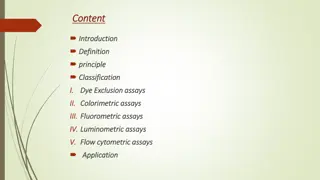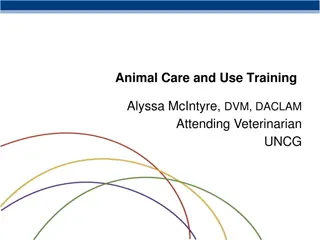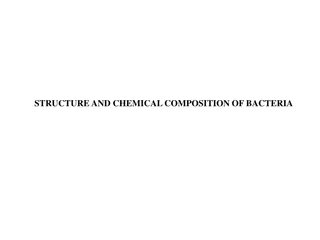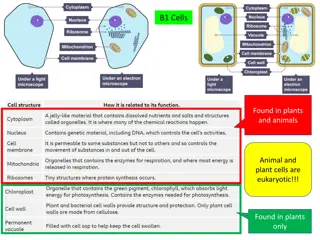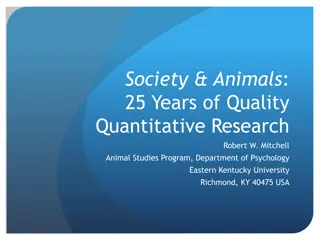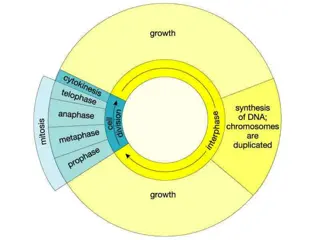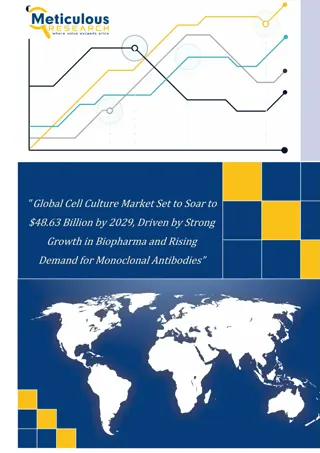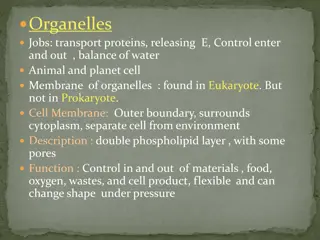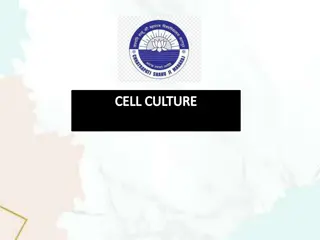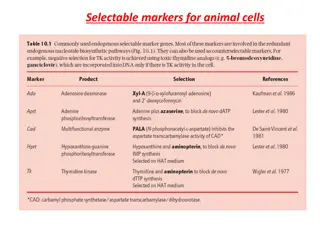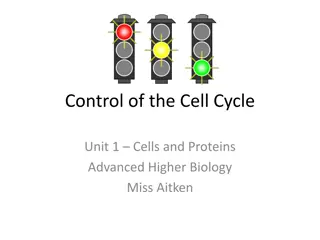
Animal Cell Culture Overview
Explore the world of animal cell culture, including primary and secondary cultures, cell lines, procedures, applications, advantages, and disadvantages. Learn about the types of animal cell cultures and their unique characteristics in this biotechnological technique.
Download Presentation

Please find below an Image/Link to download the presentation.
The content on the website is provided AS IS for your information and personal use only. It may not be sold, licensed, or shared on other websites without obtaining consent from the author. If you encounter any issues during the download, it is possible that the publisher has removed the file from their server.
You are allowed to download the files provided on this website for personal or commercial use, subject to the condition that they are used lawfully. All files are the property of their respective owners.
The content on the website is provided AS IS for your information and personal use only. It may not be sold, licensed, or shared on other websites without obtaining consent from the author.
E N D
Presentation Transcript
Animal Cell Culture Contents -What is Animal cell culture? -Primary cell culture -Secondary cell culture -Cell Lines -Procedure or Protocol of Animal cell culture- -Applications of Animal cell culture -Advantages of Animal cell culture -Disadvantages of Animal cell culture
What is Animal cell culture? Animal cell culture is a type of biotechnological technique where animal cells are artificially grown in a favourable environment. The cells used in animal cell culture are usually obtained from multicellular eukaryotes and their established cell lines. Animal cell culture is a common and widely used technique for the isolation of cells and their culture under artificial conditions.
Types of Animal cell culture Animal cell cultures can be divided into two distinct groups depending on the number of cell divisions occurring during the process; 1. Primary cell culture 2. Secondary cell culture
1. Primary cell culture Primary cell culture is the first culture obtained directly from animal tissue via mechanical and chemical disintegration or enzymatic methods. The cells of the primary cell culture are slow-growing cells that carry all the characteristics of the original tissue or cells. Since these cultures are obtained directly from the origin, they have the same number of chromosomes as the original cells. Primary cell cultures are performed in order to preserve and maintain the growth of cells on an artificial growth medium at a particular condition. Primary cell cultures can be subcultured to obtained other cultures that either continue to grow indefinitely or die after a few subcultures. The subsequent subculture of primary cell culture results in the introduction of mutations into the cells, which might result in cell lines.
1. Primary cell culture Primary cell cultures are difficult to obtain and usually have a shorter lifespan. Besides, these are prone to contamination by bacteria and viruses. The increase in cell numbers in the primary cell culture can result in exhaustion of the substrate and nutrients, which affects cellular activity. Usually, primary cell cultures need to be subcultured in order to maintain continuous cell growth once they reach the confluence stage. Primary cell cultures can be further divided into two groups depending on the kind of cells present in the culture; a. Anchorage-dependent/Adherent cells b. Anchorage-independent/ Suspension cells
Anchorage-dependent/ Anchorage-independent/ Adherent cells Suspension cells The cells in the culture require a stable biologically inert surface for adherence and growth. These cells can grow efficiently as cell suspensions and do not require a solid surface for attachment. The surface should be solid and nontoxic as these cells are difficult to grow as cell suspensions. These can be grown on liquid media continuously to obtain fresh subcultures. The ability of the cells to grow as suspension depends on the source of cells as cells that remain as suspensions in the body are effective suspension cells. These cells are usually obtained from the tissues of organs where the cells remain immobilized within the connective tissue. Examples of suspension cells include blood cells that are vascular and remain suspended in the plasma. Examples of adherent cells include kidney cells and mouse fibroblast STO cells.
2. Secondary cell culture These are obtained after the primary cell cultures are subsequently subcultured over a period of time in fresh culture media. These are formed from the enzymatic treatment of the adherent cells followed by washing and resuspension of cells in particular volumes of fresh media. They are prepared when the number of cells in the primary culture exceeds the capacity of the medium to support growth. They help to maintain an optimal cell density necessary for continued growth. The cells of the secondary cell culture might not resemble that on the parental tissue as mutations, and genetic alterations might be introduced during the subculture process. The cells can be transformed as, in some cases, the continuous subculture can lead to immortal cells.
2. Secondary cell culture Advantages over primary culture: 1. Cells of the secondary cell cultures are long-lasting as these have a higher lifespan due to the availability of appropriate nutrients at regular intervals of time. 2. Favoured over primary cell cultures as these are more readily available and are easy to grow and preserve. 3. The risk of contamination by bacteria and viruses is less as the cells transform and become less susceptible to infections. An important disadvantage associated with secondary cell culture is that the cells might develop the tendency to differentiate over a long period of time and result in aberrant cells.
Cell Lines A cell line is a group of cells that are formed from the subculture of primary culture consisting of a pure culture of cells. Cell lines usually display functional features that are close to the primary cells, but the genotype and phenotype of the cells can be modified. A cell line consists of several cell lineages with similar or different phenotypes. Cell lines can be further divided into two groups based on the growth patterns of the cells; a) Finite cell lines b) Continuous cell lines
a. Finite cell lines Finite cell lines are cell lines where the cells in the culture divide for a limited number of times, after which they eventually die. The cells in the finite cell lines can divide from 20 to 100 times before they eventually die and cannot divide anymore. The number of cell division and lifespan depends on a number of factors like cell lineage differences, species, culture conditions, and media. The cells of the finite cell lines grow as adherent cells on solid surfaces. b. Continuous cell lines Continuous cell lines are cells that exhibit indefinite growth via subsequent subcultures. The cells in the continuous cell lines grow faster to form an independent culture. The cells are immortal and can divide indefinitely. The cells in the continuous cell lines can be transformed via genetic alterations and are also tumorigenic. The transformed cells are formed from the normal primary cell cultures after treatment with chemical carcinogens or by infection with oncogenic viruses. The cells are capable of growing to prepare higher cell density and can grow as suspensions on liquid media. These cells can even grow on top of each other to form multi-layered structures on the culture vessels.
Examples of cell lines used in research
Procedure or Protocol of Animal cell culture A) Growth Requirements The culture media used for cell cultures are generally quite complex, and culture condition widely varies for each cell type. However, media generally include amino acids, vitamins, salts (maintain osmotic pressure), glucose, a bicarbonate buffer system (maintains a pH between 7.2 and 7.4), growth factors, hormones, O2and CO2. To obtain best growth, addition of a small amount of blood serum is usually necessary, and several antibiotics, like penicillin and streptomycin are added to prevent bacterial contamination. Temperature varies on the type of host cell. Most mammalian cells are maintained at 37oC for optimal growth, while cells derived from cold-blooded animals tolerate a wider temperature range (i.e. 15oC to 26oC). Actively growing cells of log phage should be used which divide rapidly during culture.
Procedure or Protocol of Animal cell culture B) Process to obtain primary cell culture Primary cell cultures are prepared from fresh tissues. Pieces of tissues from the organ are removed aseptically; which are usually minced with a sharp sterile razor and dissociated by proteolytic enzymes (such as trypsin) that break apart the intercellular cement. The obtained cell suspension is then washed with a physiological buffer (to remove the proteolytic enzymes used). The cell suspension is spread out on the bottom of a flat surface, such as a bottle or a Petri dish. This thin layer of cells adhering to the glass or plastic dish is overlaid with a suitable culture medium and is incubated at a suitable temperature
Procedure or Protocol of Animal cell culture C) Aseptic techniques Bacterial infections, like Mycoplasma and fungal infections, commonly occur in cell culture creating a problem to identify and eliminate. Thus, all cell culture work is done in a sterile environment with proper aseptic techniques. Work should be done in laminar flow with the constant unidirectional flow of HEPA filtered air over the work area. All the material, solutions and the whole atmosphere should be of contamination-free. D) Cryopreservation If a surplus of cells is available from sub-culturing, they should be treated with the appropriate protective agent (e.g., DMSO or glycerol) and stored at temperatures below 130 C until they are needed. This stores cell stocks and prevents original cell from being lost due to unexpected equipment failure or biological contaminations. It also prevents finite cells from reaching senescense and minimizes risks of changes in long term cultures.
Applications of Animal cell culture a. Production of vaccines Animal cell culture is an important technique used for the development of viral vaccine production. The technique has been used for the development of a recombinant vaccine against hepatitis B and poliovirus. Immortalized cell lines are used for the large-scale or industrial production of viral vaccines. b. Recombinant proteins Animal cell cultures can also be used for the production of recombinant therapeutic proteins like cytokines, hematopoietic growth factors, growth factors, hormones, blood products, and enzymes. Some of the common animal cell lines used for the production of these proteins are baby hamster kidney and CHO cells. c. Gene Therapy The development of animal cell culture is critical for the advances in gene therapy. Cells with faulty genes can be replaced by a functional gene in order to remove such defects and diseases.
Applications of Animal cell culture d. Model systems Cells obtained from cell culture can be studied as a model system for studies related to cell biology, host-pathogen interactions, effects of drugs, and effects due to changes in the cell composition. e. Cancer Research Animal cell culture can be used to study the differences in cancer cells and normal cells as cancer cells can also be cultured. The differences allow more detailed studies on the potential causes and effects of different carcinogenic substances. Normal cells can be culture to form cancer cells by the use of certain chemicals, viruses, and radiation. Cancer cells can also be used as test systems for studies related to the efficiencies of drugs and techniques used in cancer treatment. f. Production of Biopesticides Animal cell lines like Sf21 and Sf9 can be used for the production of biopesticides due to their faster growth rate and higher cell density.


